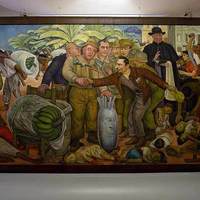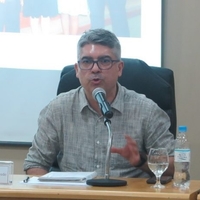Papers by Gerardo Sánchez Nateras
Peace Review, Oct 1, 2023
Latin American Research Review
This article explores Mexico’s overlooked importance in the Central American armed conflict, the ... more This article explores Mexico’s overlooked importance in the Central American armed conflict, the limits of its influence, and its connection to the late Cold War. Mexico’s policy toward Central America attempted to prevent an American and Cuban military intervention in the area and avoid a Cold War confrontation along its southern border. Mexico attempted to build detente in the region and prevent a global escalation of tension between the great powers. Meanwhile, it sought to propose a “third way” for the revolutionary actors shaped after Mexico’s political system and history. Studying Mexico’s efforts to create detente-like arrangements can shed light on the efforts of peripheral actors and their projects to influence the international system despite the actions of hegemonic powers.
Secuencia
Este trabajo abordará el movimiento mexicano de solidaridad con el pueblo de Nicaragua durante la... more Este trabajo abordará el movimiento mexicano de solidaridad con el pueblo de Nicaragua durante la insurrección sandinista (1977-1979), aportando elementos para el estudio de la historia transnacional de la revolución en Nicaragua y su impacto en la vida política mexicana. Se abordará el movimiento de solidaridad como un proceso heterogéneo dominado por tres actores fundamentales: el FSLN, el Estado mexicano y la izquierda política mexicana, cada uno intentando avanzar sus intereses particulares mediante la movilización política y el uso de la retórica de solidaridad. Se estudiarán algunos temas relacionados con la izquierda partidista y sindical en el contexto de la reforma política de 1977, el gobierno de José López Portillo y su política hacia el FSLN y la izquierda mexicana, así como los esfuerzos de propaganda y activismo del Sandinismo en México.

Iberoforum. Revista de Ciencias Sociales, 2021
La desaparición forzada es una grave violación a los derechos humanos con una larga historia. Ent... more La desaparición forzada es una grave violación a los derechos humanos con una larga historia. Entre 1964 y 1985, el Estado mexicano se enfrentó y reprimió a sus enemigos internos: opositores, movimientos sociales, organizaciones político-militares y sus simpatizantes. Para ello se valió sistemáticamente de la desaparición forzada como una herramienta para aterrorizar, desmovilizar y exterminar a adversarios reales o imaginados. Esclarecer el paradero de estas personas implica integrar y estructurar una gran cantidad de información dispersa en diversas fuentes documentales creadas por instituciones de seguridad del Estado, colectivos de búsqueda, academia, periodistas e instancias públicas que se propusieron, años después, investigar estos hechos. En este trabajo proponemos un enfoque interdisciplinario para generar una representación formal del conocimiento contenido en las fuentes, la cual pueda complementar el entendimiento histórico del problema. El resultado es una ontología com...

Cold War History, 2018
This paper seeks to understand the construction of a broad alliance between the Sandinista Nation... more This paper seeks to understand the construction of a broad alliance between the Sandinista National Liberation Front (FSLN), a socialist inspired guerrilla group, and various Latin American liberal and authoritarian governments, mainly Venezuela, Costa Rica, Panama and Cuba, between 1977 and 1979. I will seek to understand the construction of this unusual partnership, as well as the deep conflicts and mistrust that existed between the parties during the revolutionary upheaval in Nicaragua. This process will be examined by analysing the way Cold War politics and Latin American regional tensions shaped the events leading to the Sandinista revolution. This paper tells the story of how some Latin American countries sought to avoid radical change and ended up supporting a revolution instead. It will study the reasons why Venezuela, Panama, and Costa Rica ended up supporting the Sandinista National Liberation Front against the wishes of the United States. In doing so, they built a new political paradigm that envisioned the end of the bipolar conflict. The article will further show the impact of the Carter Administration's policy of nonintervention, and later on multilateralism, and its profound impact on the Nicaraguan regional crisis. Of particular importance will be the study of the process of radicalisation of Venezuela, Panama, and Costa Rica in the context of an increased attempt by the American government to exercise non-intervention in Latin America, and the gradual, and in a certain way reluctant, involvement of Cuba in the crisis. The purpose of this work is to study how these dynamics fostered the decomposition of the bipolar paradigm in inter-American relations and the creation of a new political configuration in the region. The history of the American government's involvement in the Nicaraguan Revolution has been extensively studied by historians. 1 However, the United States was only one of the actors in the revolutionary drama. While the non-interventionist desire of the United States
Monograma. Revista Iberoamericana de Cultura y Pensamiento, 2018
El trabajo abordará la manera en la que la facción Tercerista del FSLN buscó promover a Edén Past... more El trabajo abordará la manera en la que la facción Tercerista del FSLN buscó promover a Edén Pastora, como un ícono revolucionario socialdemócrata para aplacar el temor de la burguesía nicaragüense y los aliados internacionales del FSLN ante las posibilidades de una nueva revolución comunista en el continente. El texto abordará la complicada relación entre el FSLN y sus aliados internacionales, destacando la forma en la que éstos buscaron influir en el programa político de la revolución y la manera en la que los sandinistas respondieron ante las presiones internacionales de sus aliados, en el contexto general de la Guerra Fría en América Latina .
Secuencia, 2021
Esta obra está protegida bajo una Licencia Creative Commons Atribución-NoComercial 4.0 Internacio... more Esta obra está protegida bajo una Licencia Creative Commons Atribución-NoComercial 4.0 Internacional.
Books by Gerardo Sánchez Nateras
The Last Revolution, the Inter-American Cold War and the Sandinista Revolution











Uploads
Papers by Gerardo Sánchez Nateras
Books by Gerardo Sánchez Nateras